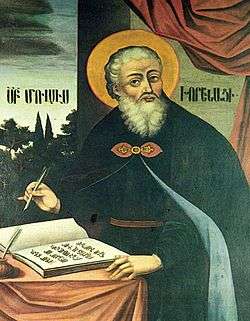Sebeos
Sebeos (Armenian: Սեբեոս) was a 7th-century Armenian bishop and historian.
Little is known about the author, though a signature on the resolution of the Ecclesiastical Council of Dvin in 645 reads 'Bishop Sebeos of Bagratunis.' His writings are valuable as one of the few intact surviving sources that chronicle sixth century Armenia and its surrounding territories.[1] The history of Sebeos contains detailed descriptions from the period of Sassanid supremacy in Armenia up to the Islamic conquest in 661. His history was published for the first time in 1851 in Istanbul.[2]
Writings
To him has been attributed the A History of Heraclius, chronicling events from the end of the fifth century to 661.[3] The first section begins with the mythical foundation of Armenia with the Legend of Hyke and Bel, moving to contemporary history with the ascent of Vardan II Mamikonian in 570. From there, he relates the struggles and alliances between Persia and Byzantium.
The second section narrates the ascent of a new political and military force, the Ishmaelites (i.e. Arabs).
This section describes how Mahmed first established a community comprising Ishmaelites and Jews based on their common descent from Abraham; the Arabs via Ishmael, and the Jews via Isaac.[4] From there, the Ishmaelites made dramatic territorial gains, including their victory over the Sassanian dynasty, and the narrative goes in to the division of the Ishmaelite armies and the beginnings of the First Fitna. He relates these developments to Armenia. He stops with the end of first fitna, as Muawiyah I makes peace with all.
References
- Hacikyan, Agop; Basmanjian, Bagriel; Franchuk, Edward; Ouzounian, Nourhan (2002). The Heritage of Armenian Literature Volume II. Detroit, Michigan: Wayne State University Press. p. 82. ISBN 0-8143-3023-1. Retrieved 13 March 2015.
- Hacikyan, Jack (2002). The Heritage of Armenian Literature: From the sixth to the Eighteenth Century. p. 81. ISBN 0814330231.
- Ararat, Volume 27. Armenian General Benevolent Union. p. 16. to him
- Howard-Johnston, James (1999-11-01). The Armenian History Attributed to Sebeos. Liverpool University Press. pp. li. ISBN 0-85323-564-3.
Literature
- The Armenian History attributed to Sebeos, translated, with Notes, by R. W. Thomson, historical Commentary by J. Howard-Johnston, Assistance from T. Greenwood (Translated Texts for Historians), 2 Volumes, Liverpool 1999.
- T. Greenwood, "Sasanian Echoes and Apocalyptic Expectations: A Re-Evaluation of the Armenian History attributed to Sebeos", Le Muséon 115, Fasc. 1—2 (2002) 323—397.
External links
- Sebeos' History
- Translator's Preface
- English translation of the History - mirror if main site unavailable
- Sebeos' History, Russian translation, S.Petersburg 1862.
- Encyclopedia Iranica's Article on Sebeos
